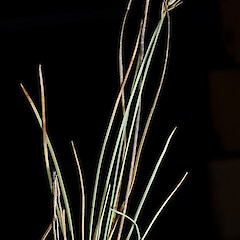Carex cheesemaniana
Common name
hook sedge, bastard grass
Synonyms
Uncinia compacta R.Br. var. nervosa (Boott) C.B.Clarke; Uncinia cheesemanniana Boeck; Uncinia nervosa Boott
Family
Cyperaceae
Flora category
Vascular – Native
Endemic taxon
No
Endemic genus
No
Endemic family
No
Structural class
Sedges
NVS code
The National Vegetation Survey (NVS) Databank is a physical archive and electronic databank containing records of over 94,000 vegetation survey plots - including data from over 19,000 permanent plots. NVS maintains a standard set of species code abbreviations that correspond to standard scientific plant names from the Ngä Tipu o Aotearoa - New Zealand Plants database.
UNCNER
Chromosome number
2n = 88
Current conservation status
The conservation status of all known New Zealand vascular plant taxa at the rank of species and below were reassessed in 2017 using the New Zealand Threat Classification System (NZTCS) – more information about this can be found on the NZTCS website. This report includes a statistical summary and brief notes on changes since 2012 and replaces all previous NZTCS lists for vascular plants.
Please note, threat classifications are often suggested by authors when publications fall between NZTCS assessment periods – an interim threat classification status has not been assessed by the NZTCS panel.
- Conservation status of New Zealand indigenous vascular plants, 2017 . 2018. Peter J. de Lange, Jeremy R. Rolfe, John W. Barkla, Shannel P. Courtney, Paul D. Champion, Leon R. Perrie, Sarah M. Beadel, Kerry A. Ford, Ilse Breitwieser, Ines Schönberger, Rowan Hindmarsh-Walls, Peter B. Heenan and Kate Ladley. Department of Conservation. Source: NZTCS and licensed by DOC for reuse under the Creative Commons Attribution 4.0 International licence.
2017 | Not Threatened | Qualifiers: SO
Previous conservation statuses
2012 | Not Threatened
2009 | Not Threatened
2004 | Not Threatened
Distribution
Indigenous. New Zealand: South Island. Also Tasmania
Habitat
A local to locally common species of wet ground and bogs in montane forest or in subalpine to alpine snow-tussock (Chionochloa) grassland.
Wetland plant indicator status rating
Information derived from the revised national wetland plant list prepared to assist councils in delineating and monitoring wetlands (Clarkson et al., 2021 Manaaki Whenua – Landcare Research Contract Report LC3975 for Hawke’s Bay Regional Council). The national plant list categorises plants by the extent to which they are found in wetlands and not ‘drylands’. The indicator status ratings are OBL (obligate wetland), FACW (facultative wetland), FAC (facultative), FACU (facultative upland), and UPL (obligate upland). If you have suggestions for the Wetland Indicator Status Rating, please contact: [Enable JavaScript to view protected content]
FACW: Facultative Wetland
Usually is a hydrophyte but occasionally found in uplands (non-wetlands).
Detailed description
Bright to dark green, lax or densely caespitose plants. Culms 100–300 mm long, usually slightly < but occasionally > 0.5 mm diameter, glabrous; basal bracts dull grey-brown. Leaves 4–6 per culm, slightly < flowering culms, much < mature culms, c. 0.5 mm wide, plano-convex or concavo-convex, rigid, linear, scarcely narrowed to the obtuse tip, margins scabrid. Spikes 15–30 × 2–6 mm, oblong, female flowers 2–12, ± close-set, internodes 1.5–4.0 mm long. Glumes < or > utricles, deciduous, lanceolate, subacute, sides membranous, midrib green. Utricles 4–6 × c. 1 mm, trigonous, elliptic-lanceolate, greenish brown to dark brown, lateral nerves prominent, shining, very slightly contracted to a broad stipe c. 1 mm long, beak 1.0–1.5 mm long.
Flowering
November–January
Fruiting
December–March
Propagation technique
Easily grown from fresh seed and the division of whole plants. Prefers cool, damp ground but once established will tolerate drought. Excellent in semi-shade.
Etymology
carex: Latin name for a species of sedge, now applied to the whole group.
Taxonomic Notes
The epithet ‘cheesemanniana’ (Global Carex Group 2015) based on Uncinia cheesemanniana Boeckeler is an orthographic error here corrected to ‘cheesemaniana’ (see Art. 60, International Code of Nomenclature, Melbourne Code, 2011) - http://www.iapt-taxon.org/nomen/main.php?page=art60
Attribution
Description adapted from Moore and Edgar (1970). Fact sheet prepared by Peter J. de Lange 17 August 2006.
References and further reading
Global Carex Group. 2015. Making Carex monophyletic (Cyperaceae, tribe Cariceae): a new broader circumscription. Botanical Journal of the Linnean Society 179: 1–42. https://doi.org/10.1111/boj.12298.
Moore LB, Edgar E. 1970. Flora of New Zealand, Volume II. Indigenous Tracheophyta: Monocotyledones except Gramineae. Government Printer, Wellington, NZ. 354 p.
NZPCN Fact Sheet citation
Please cite as: de Lange, P.J. (Year at time of access): Carex cheesemaniana Fact Sheet (content continuously updated). New Zealand Plant Conservation Network. https://www.nzpcn.org.nz/flora/species/carex-cheesemaniana/ (Date website was queried)


